
Coral Sea order of battle
Encyclopedia
This is an order of battle
for the Battle of the Coral Sea
. The battle, fought during May 4–8, 1942, was a major naval battle
in the Pacific Theater
of World War II
between the Imperial Japanese Navy
and Allied
naval and air forces from the United States
(U.S.) and Australia
.
In an attempt to strengthen their defensive positioning for their empire in the South Pacific, Imperial Japanese
forces decided to invade and occupy Port Moresby
in New Guinea
and Tulagi
in the southeastern Solomon Islands
. The plan to accomplish this, called Operation MO
, involved several major units of Japan's Combined Fleet
, including two fleet carrier
s and a light carrier
to provide air cover for the invasion fleets, under the overall command of Shigeyoshi Inoue
. The U.S. learned of the Japanese plan through signals intelligence and sent two United States Navy
carrier task forces and a joint Australian
-American cruiser
force, under the overall command of Frank Jack Fletcher
, to oppose the Japanese offensive.
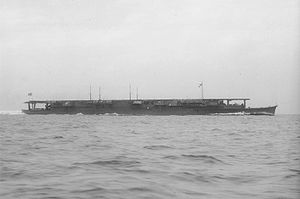
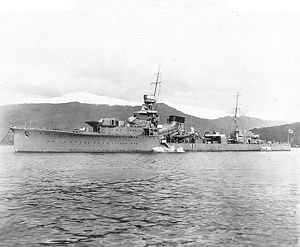

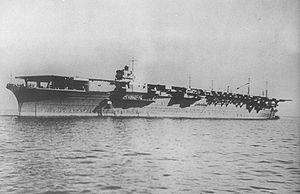
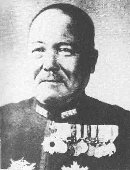
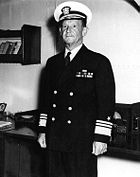

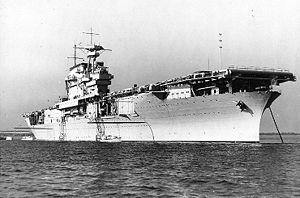
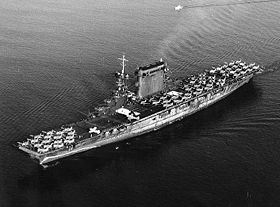
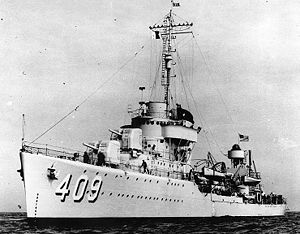
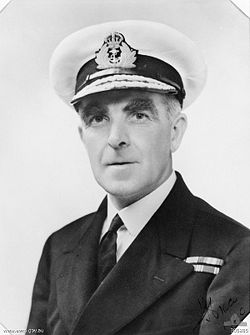 Task Force 17 - Vice Admiral Frank Jack Fletcher
Task Force 17 - Vice Admiral Frank Jack Fletcher
South West Pacific Area – General Douglas MacArthur
Order of battle
In modern use, the order of battle is the identification, command structure, strength, and disposition of personnel, equipment, and units of an armed force participating in field operations. Various abbreviations are in use, including OOB, O/B, or OB, while ORBAT remains the most common in the...
for the Battle of the Coral Sea
Battle of the Coral Sea
The Battle of the Coral Sea, fought from 4–8 May 1942, was a major naval battle in the Pacific Theater of World War II between the Imperial Japanese Navy and Allied naval and air forces from the United States and Australia. The battle was the first fleet action in which aircraft carriers engaged...
. The battle, fought during May 4–8, 1942, was a major naval battle
Naval battle
A naval battle is a battle fought using boats, ships or other waterborne vessels. Most naval battles have occurred at sea, but a few have taken place on lakes or rivers. The earliest recorded naval battle took place in 1210 BC near Cyprus...
in the Pacific Theater
Pacific War
The Pacific War, also sometimes called the Asia-Pacific War refers broadly to the parts of World War II that took place in the Pacific Ocean, its islands, and in East Asia, then called the Far East...
of World War II
World War II
World War II, or the Second World War , was a global conflict lasting from 1939 to 1945, involving most of the world's nations—including all of the great powers—eventually forming two opposing military alliances: the Allies and the Axis...
between the Imperial Japanese Navy
Imperial Japanese Navy
The Imperial Japanese Navy was the navy of the Empire of Japan from 1869 until 1947, when it was dissolved following Japan's constitutional renunciation of the use of force as a means of settling international disputes...
and Allied
Allies of World War II
The Allies of World War II were the countries that opposed the Axis powers during the Second World War . Former Axis states contributing to the Allied victory are not considered Allied states...
naval and air forces from the United States
United States
The United States of America is a federal constitutional republic comprising fifty states and a federal district...
(U.S.) and Australia
Australia
Australia , officially the Commonwealth of Australia, is a country in the Southern Hemisphere comprising the mainland of the Australian continent, the island of Tasmania, and numerous smaller islands in the Indian and Pacific Oceans. It is the world's sixth-largest country by total area...
.
In an attempt to strengthen their defensive positioning for their empire in the South Pacific, Imperial Japanese
Empire of Japan
The Empire of Japan is the name of the state of Japan that existed from the Meiji Restoration on 3 January 1868 to the enactment of the post-World War II Constitution of...
forces decided to invade and occupy Port Moresby
Port Moresby
Port Moresby , or Pot Mosbi in Tok Pisin, is the capital and largest city of Papua New Guinea . It is located on the shores of the Gulf of Papua, on the southeastern coast of the island of New Guinea, which made it a prime objective for conquest by the Imperial Japanese forces during 1942–43...
in New Guinea
New Guinea
New Guinea is the world's second largest island, after Greenland, covering a land area of 786,000 km2. Located in the southwest Pacific Ocean, it lies geographically to the east of the Malay Archipelago, with which it is sometimes included as part of a greater Indo-Australian Archipelago...
and Tulagi
Tulagi
Tulagi, less commonly Tulaghi, is a small island in the Solomon Islands, just off the south coast of Florida Island. The town of the same name on the island Tulagi, less commonly Tulaghi, is a small island (5.5 km by 1 km) in the Solomon Islands, just off the south coast of Florida...
in the southeastern Solomon Islands
Solomon Islands
Solomon Islands is a sovereign state in Oceania, east of Papua New Guinea, consisting of nearly one thousand islands. It covers a land mass of . The capital, Honiara, is located on the island of Guadalcanal...
. The plan to accomplish this, called Operation MO
Operation Mo
Operation Mo or the Port Moresby Operation was the name of the Japanese plan to take control of the Australian Territory of New Guinea during World War II as well as other locations in the South Pacific with the goal of isolating Australia and New Zealand from their ally the United States...
, involved several major units of Japan's Combined Fleet
Combined Fleet
The was the main ocean-going component of the Imperial Japanese Navy. The Combined Fleet was not a standing force, but a temporary force formed for the duration of a conflict or major naval maneuvers from various units normally under separate commands in peacetime....
, including two fleet carrier
Fleet carrier
A fleet carrier is an aircraft carrier that is designed to operate with the main fleet of a nation's navy. The term was developed during the Second World War, to distinguish it from the escort carrier and other lesser types...
s and a light carrier
Light aircraft carrier
A light aircraft carrier is an aircraft carrier that is smaller than the standard carriers of a navy. The precise definition of the type varies by country; light carriers typically have a complement of aircraft only ½ to ⅔ the size of a full-sized or "fleet" carrier.-History:In World War II, the...
to provide air cover for the invasion fleets, under the overall command of Shigeyoshi Inoue
Shigeyoshi Inoue
was an admiral in the Imperial Japanese Navy during World War II. He was commander of the Japanese 4th Fleet and later served as Vice-Minister of the Navy. A noted naval theorist, he was a strong advocate of naval aviation within the Japanese Navy...
. The U.S. learned of the Japanese plan through signals intelligence and sent two United States Navy
United States Navy
The United States Navy is the naval warfare service branch of the United States Armed Forces and one of the seven uniformed services of the United States. The U.S. Navy is the largest in the world; its battle fleet tonnage is greater than that of the next 13 largest navies combined. The U.S...
carrier task forces and a joint Australian
Royal Australian Navy
The Royal Australian Navy is the naval branch of the Australian Defence Force. Following the Federation of Australia in 1901, the ships and resources of the separate colonial navies were integrated into a national force: the Commonwealth Naval Forces...
-American cruiser
Cruiser
A cruiser is a type of warship. The term has been in use for several hundreds of years, and has had different meanings throughout this period...
force, under the overall command of Frank Jack Fletcher
Frank Jack Fletcher
Frank Jack Fletcher was an admiral in the United States Navy during World War II. Fletcher was the operational commander at the pivotal Battles of Coral Sea and of Midway. He was the nephew of Admiral Frank Friday Fletcher.-Early life and early Navy career:Fletcher was born in Marshalltown, Iowa...
, to oppose the Japanese offensive.
Japanese Forces
Task Force MOOperation Mo
Operation Mo or the Port Moresby Operation was the name of the Japanese plan to take control of the Australian Territory of New Guinea during World War II as well as other locations in the South Pacific with the goal of isolating Australia and New Zealand from their ally the United States...





- IJN 4th FleetIJN 4th FleetThe was a fleet designation of the Imperial Japanese Navy. The Fourth Fleet designation was used during three separate periods. The initial designation was for a group of ships that were assigned to work together during the Russo-Japanese conflict and the period of its immediate aftermath...
- Vice Admiral Shigeyoshi InoueShigeyoshi Inouewas an admiral in the Imperial Japanese Navy during World War II. He was commander of the Japanese 4th Fleet and later served as Vice-Minister of the Navy. A noted naval theorist, he was a strong advocate of naval aviation within the Japanese Navy...
- light cruiserLight cruiserA light cruiser is a type of small- or medium-sized warship. The term is a shortening of the phrase "light armored cruiser", describing a small ship that carried armor in the same way as an armored cruiser: a protective belt and deck...
KashimaJapanese cruiser Kashimawas the second vessel completed of the three light cruisers in Katori class, which served with the Imperial Japanese Navy during World War II. It is named after the noted Shinto shrine Kashima Jingu in Ibaraki prefecture, Japan.-Background:...
(Inoue's flagship, anchored at RabaulRabaulRabaul is a township in East New Britain province, Papua New Guinea. The town was the provincial capital and most important settlement in the province until it was destroyed in 1994 by falling ash of a volcanic eruption. During the eruption, ash was sent thousands of metres into the air and the...
during the battle)
- light cruiser
- Tulagi Invasion Group - Rear Admiral Kiyohide Shima
- minelayers OkinoshimaJapanese minelayer Okinoshimawas a large minelayer of the Imperial Japanese Navy, which was in service during the early stages of World War II. She was named after the Okinoshima Island in the Sea of Japan and the earlier...
(Shima's flagship), Kōei Maru - transport Azumasan Maru
- destroyers Kikuzuki (sunk), YūzukiJapanese destroyer Yuzukiwas the final of twelve destroyers, built for the Imperial Japanese Navy following World War I. Advanced for their time, these ships served as first-line destroyers through the 1930s, but were considered obsolescent by the start of the Pacific War...
- minesweepers Wa #1 (sunk), Wa #2 (sunk), Hagoromo Maru, Noshiro Maru #2, and Tama Maru (sunk)
- subchasers Toshi Maru #3 and Tama Maru #8
- 400 troops from the 3rd Kure Special Naval Landing Force (SNLF) plus a construction detachment from the 7th Establishment Squad.
- minelayers Okinoshima
- Support Group/Close Cover Force - Rear Admiral Kuninori MarumoKuninori Marumo, was an admiral in the Imperial Japanese Navy during World War II.-Biography:Marumo was a native of Nagano prefecture. He graduated from the 40th class of the Imperial Japanese Naval Academy in 1912, ranked 47th out of 144 cadets....
- light cruisers TenryūJapanese cruiser Tenryuwas the lead ship in the two-ship of light cruisers of the Imperial Japanese Navy. Tenryū was named after the Tenryū River in Nagano and Shizuoka prefectures.-Background:...
(Marumo's flagship), Tatsuta - seaplane tender Kamikawa MaruJapanese seaplane tender Kamikawa Maruwas a seaplane tender in the Imperial Japanese Navy . The ship was initially built at Kawasaki's Kōbe Shipyard and launched on 13 December 1936 as a merchant vessel for the Kawasaki Kisen K. K. Line. On 18 September 1937 the IJN requisitioned as an aircraft transport ship and was refitted in 1939...
- Kamikawa Maru air group - 12 aircraft
- Kiyokawa MaruJapanese seaplane tender Kiyokawa Maruwas a seaplane tender in the Imperial Japanese Navy . The ship was built at Kawasaki's Kōbe Shipyard and launched on 13 December 1936 as a merchant vessel for the Kawasaki Kisen K. K. Line. Kyokawa Maru was involved in a collision with the small train ferry Uko Maru No. 1 on 19 August 1937 in the...
air group (attached)
- gunboats Keijo Maru, Seikai Maru, Nikkai Maru
- light cruisers Tenryū
- Covering Group/Main Body Support Force - Rear Admiral Aritomo GotōAritomo Gotowas an admiral in the Imperial Japanese Navy during World War II.-Early career:Gotō was born in Ibaraki prefecture in 1888. He graduated from the 38th class of the Imperial Japanese Naval Academy in 1910, ranked 30th out of a class of 149 cadets. As a midshipman, he served on the cruiser and...
- light carrier ShōhōJapanese aircraft carrier ShohoShōhō , the lead ship of her class, was a light aircraft carrier of the Imperial Japanese Navy during World War II...
(sunk) - Shōhō Air Group - Lieutenant Kenjirō Nōtomi
- Shōhō Carrier Fighter Unit - 8 A6M ZeroA6M ZeroThe Mitsubishi A6M Zero was a long-range fighter aircraft operated by the Imperial Japanese Navy Air Service from 1940 to 1945. The A6M was designated as the , and also designated as the Mitsubishi A6M Rei-sen and Mitsubishi Navy 12-shi Carrier Fighter. The A6M was usually referred to by the...
and 4 Mitsubishi A5MMitsubishi A5MThe Mitsubishi A5M, Japanese Navy designation was "Type 96 carrier-based fighter" was a Japanese carrier-based fighter aircraft. It was the world's first monoplane shipboard fighter and the direct ancestor of the famous Mitsubishi A6M 'Zero'...
fighters - Shōhō Carrier Attack Unit - 6 Nakajima B5NNakajima B5N|-See also:-References:NotesBibliography* Bridgwater, H.C. and Peter Scott. Combat Colours Number 4: Pearl Harbor and Beyond, December 1941 to May 1942. Luton, Bedfordshire, UK: Guideline Publications, 2001. ISBN 0-9539040-6-7....
Type 97 torpedo bombers
- Shōhō Carrier Fighter Unit - 8 A6M Zero
- cruisers AobaJapanese cruiser Aobawas the lead ship in the two-vessel Aoba-class of heavy cruisers in the Imperial Japanese Navy. It is named after Mount Aoba, a volcano located behind Maizuru, Kyoto.-Background:...
(Gotō's flagship), KakoJapanese cruiser Kakowas the second vessel in the two-vessel Furutaka-class of heavy cruisers in the Imperial Japanese Navy. It was named after the Kakogawa River in Hyogo prefecture, Japan.-Background:...
, KinugasaJapanese cruiser Kinugasawas the second vessel in the two-vessel Aoba-class of heavy cruisers in the Imperial Japanese Navy. It was named after Mount Kinugasa, located in Yokosuka, Kanagawa, Japan.- Background :...
, FurutakaJapanese cruiser Furutakawas the lead ship in the two-vessel Furutaka-class of heavy cruisers in the Imperial Japanese Navy. It was named after Mount Furutaka, located on Etajima, Hiroshima immediately behind the Imperial Japanese Navy Academy.-Design:... - destroyer SazanamiJapanese destroyer Sazanamiwas the nineteenth of twenty-four s, built for the Imperial Japanese Navy following World War I. When introduced into service, these ships were the most powerful destroyers in the world...
- light carrier Shōhō
- Port Moresby Invasion Group - Rear Admiral Sadamichi KajiokaSadamichi Kajioka-Notes:...
- light cruiser YubariJapanese cruiser Yubariwas a light cruiser built between 1922 and 1923 for the Imperial Japanese Navy. She fought in World War II and was sunk by the US Navy.-Design:The ship originated as an experimental scout cruiser, which would have the combat potential of the standard Japanese light cruisers on a much lighter ship....
(Kajioka's flagship) - destroyers OiteJapanese destroyer Oite (1924)was the sixth vessel of the Kamikaze-class destroyers built for the Imperial Japanese Navy following World War I. Advanced for their time, these ships served as first-line destroyers through the 1930s, but were considered obsolescent by the start of the Pacific War.-History:Construction of the...
, AsanagiJapanese destroyer Asanagiwas the eighth vessel of the Kamikaze-class destroyers built for the Imperial Japanese Navy following World War I. Advanced for their time, these ships served as first-line destroyers through the 1930s, but were considered obsolescent by the start of the Pacific War.-History:Construction of the...
, Uzuki, MutsukiJapanese destroyer Mutsukiwas the lead ship of twelve destroyers, built for the Imperial Japanese Navy following World War I. Advanced for their time, these ships served as first-line destroyers through the 1930s, but were considered obsolescent by the start of the Pacific War.-History:...
, MochizukiJapanese destroyer Mochizukiwas one of twelve destroyers, built for the Imperial Japanese Navy following World War I. Advanced for their time, these ships served as first-line destroyers through the 1930s, but were considered obsolescent by the start of the Pacific War...
, Yayoi - 1 or 2 unidentified patrol boats
- Transport Unit - Rear Admiral Kōsō AbeKoso Abewas an admiral in the Imperial Japanese Navy during World War II.-Early career:A native of Yamagata prefecture in northern Japan, Abe was a graduate of the 40th class of the Imperial Japanese Naval Academy in 1912. He ranked 73rd out of 144 cadets. He served as midshipman on the cruisers and from...
- minelayer TsugaruJapanese minelayer Tsugaruwas a large minelayer of the Imperial Japanese Navy that was in service during the early stages of World War II. She was named after the earlier , which in turn was named after Tsugaru Peninsula in northwest Aomori Prefecture of Japan...
- 11 transports:
- Imperial Japanese NavyImperial Japanese NavyThe Imperial Japanese Navy was the navy of the Empire of Japan from 1869 until 1947, when it was dissolved following Japan's constitutional renunciation of the use of force as a means of settling international disputes...
(IJN)- Mogamigawa Maru, Akihasan Maru, Chōwa Maru, Goyō Maru, Shōkai Maru - Imperial Japanese ArmyImperial Japanese Army-Foundation:During the Meiji Restoration, the military forces loyal to the Emperor were samurai drawn primarily from the loyalist feudal domains of Satsuma and Chōshū...
(IJA)- China Maru, Daifuku Maru, Asakayama (Asakasan) Maru, Marsue (Matsue) Maru, Mito Maru, Nichibi Maru.
- Imperial Japanese Navy
- repair ship Ojima
- oilers Hoyo Maru, and IrōJapanese oiler Irōwas a fleet oiler for the Imperial Japanese Navy. A member of the Notoro-class of oilers, the ship was launched on August 5, 1922 and served Japan during the Pacific Campaign of World War II. On March 31, 1944 the ship was attacked and sunk in Palau Harbor by United States Navy aircraft carrier...
- minesweepers W-20 (Wa #20), Hagoromo Maru, Noshiro Maru #2, Fumi Maru #2, and Seki Maru #3.
- Approximately 500 troops from the 3rd Kure SNLF plus construction specialists from the 10th Establishment Squad on the IJN transports
- South Seas DetachmentSouth Seas DetachmentThe South Seas Detachment of the Imperial Japanese Army was a brigade-size force formed in 1941 to be the army unit used in the Japanese seizure of the South Pacific island groups of Wake, Guam and the Gilberts. As part of the South Seas Force, it fell under Imperial Japanese Navy command and...
of approximately 5,000 troops on the IJA transports
- minelayer Tsugaru
- light cruiser Yubari
- Carrier Striking Force - Vice Admiral Takeo TakagiTakeo Takagiwas an admiral in the Imperial Japanese Navy during World War II.-Biography:Takagi was a native of Iwaki city, Fukushima prefecture. He was a graduate of the 39th class of the Imperial Japanese Naval Academy, ranking 17th of 148 cadets in 1911...
- Carrier Division 5 - Rear Admiral Chūichi HaraChuichi Hara-External links:*...
, Officer in Tactical Command- Carrier ShōkakuJapanese aircraft carrier ShokakuShōkaku was an aircraft carrier of the Imperial Japanese Navy, the lead ship of her class. Along with her sister ship , she took part in several key naval battles during the Pacific War, including the attack on Pearl Harbor, the Battle of the Coral Sea and the Battle of the Santa Cruz Islands...
- Shōkaku Air Group - Lieutenant Commander Kakuichi Takahashi
- Shōkaku Carrier Fighter Unit - 21 A6M ZeroA6M ZeroThe Mitsubishi A6M Zero was a long-range fighter aircraft operated by the Imperial Japanese Navy Air Service from 1940 to 1945. The A6M was designated as the , and also designated as the Mitsubishi A6M Rei-sen and Mitsubishi Navy 12-shi Carrier Fighter. The A6M was usually referred to by the...
fighters - Shōkaku Carrier Bomber Unit - 20 Aichi D3AAichi D3AThe , Allied reporting name "Val") was a World War II carrier-borne dive bomber of the Imperial Japanese Navy . It was the primary dive bomber in the Imperial Japanese Navy, and participated in almost all actions, including Pearl Harbor....
Type 99 dive bombers - Shōkaku Carrier Attack Unit - 19 Nakajima B5NNakajima B5N|-See also:-References:NotesBibliography* Bridgwater, H.C. and Peter Scott. Combat Colours Number 4: Pearl Harbor and Beyond, December 1941 to May 1942. Luton, Bedfordshire, UK: Guideline Publications, 2001. ISBN 0-9539040-6-7....
Type 97 torpedo bombers
- Shōkaku Carrier Fighter Unit - 21 A6M Zero
- Carrier ZuikakuJapanese aircraft carrier ZuikakuZuikaku was a Shōkaku-class aircraft carrier of the Imperial Japanese Navy. Her complement of aircraft took part in the attack on Pearl Harbor that formally brought the United States into the Pacific War, and she fought in several of the most important naval battles of the war, finally being sunk...
(Hara's flagship) - Zuikaku Air Group - Lieutenant Commander Shigekazu Shimazaki
- Zuikaku Carrier Fighter Unit - 25 Zero fighters
- Zuikaku Carrier Bomber Unit - 22 Type 99 dive bombers
- Zuikaku Carrier Attack Unit - 20 Type 97 torpedo bombers
- Carrier Shōkaku
- cruisers MyōkōJapanese cruiser Myokowas the name-ship of the four-member of heavy cruisers of the Imperial Japanese Navy — the other ships of the class being the Nachi, Ashigara, and Haguro....
(Takagi's flagship), HaguroJapanese cruiser Haguro|-External reference links: -External links:**... - destroyers UshioJapanese destroyer Ushiowas the twentieth of twenty-four destroyers, built for the Imperial Japanese Navy following World War I. When introduced into service, these ships were the most powerful destroyers in the world. They served as first-line destroyers through the 1930s, and remained formidable weapons systems well...
, AkebonoJapanese destroyer Akebonowas the eighteenth of twenty-four destroyers, built for the Imperial Japanese Navy following World War I. When introduced into service, these ships were the most powerful destroyers in the world... - destroyers AriakeJapanese destroyer Ariakewas the fifth of six destroyers, built for the Imperial Japanese Navy under the Circle One Program . Three were laid down in JFY 1931 and the next three in JFY 1933...
, YugureJapanese destroyer Yugurewas the sixth and last destroyer, built for the Imperial Japanese Navy under the Circle One Program . Three were laid down in JFY 1931 and the next three in JFY 1933...
, ShiratsuyuJapanese destroyer Shiratsuyuwas the lead ship of ten destroyers, and first of six to be built for the Imperial Japanese Navy under the Circle One Program .-History:...
, ShigureJapanese destroyer Shigurewas the second of ten s, and the first to be built for the Imperial Japanese Navy under the Circle One Program . Along with the destroyer , she developed a reputation within the Imperial Japanese Navy for being "lucky" or "unsinkable", emerging as the sole surviving Japanese warship from numerous... - oiler Tōhō Maru
- Carrier Division 5 - Rear Admiral Chūichi Hara
- Submarine Force - Captain Noburu Ishizaki
- Patrol/Scouting Group - I-21Japanese submarine I-21was a Japanese Type B1 submarine which saw service during World War II in the Imperial Japanese Navy. She displaced 1,950 tons and had a speed of . I-21 was the most successful Japanese submarine to operate in Australian waters, participating in the attack on Sydney Harbour in 1942 and sinking...
, I-22Japanese submarine I-22I-22 was a submarine of the Imperial Japanese Navy which saw service during the Pacific Campaign of World War II. I-22 was commissioned at Yokosuka, Japan on March 10, 1941. The submarine participated in the Battle of the Coral Sea and attack on Sydney Harbour in May and June 1942...
, I-24Japanese submarine I-24I-24 was a submarine of the Imperial Japanese Navy which saw service during the Pacific Campaign of World War II. I-24 was commissioned at Sasebo, Japan on October 31, 1941...
, I-28Japanese submarine I-28I-28 was a submarine of the Imperial Japanese Navy which saw service during the Pacific Campaign of World War II. I-28 was commissioned at Kobe, Japan on February 6, 1942. The submarine participated in the Battle of the Coral Sea in May 1942...
, and I-29Japanese submarine I-29I-29, code-named Matsu , was a B1 type submarine of the Imperial Japanese Navy used during World War II on two secret missions with Germany, during one of which she was sunk.-Type B Submarines:... - Raiding Group - RO-33Japanese submarine Ro-33Ro-33 was a Ro-33-class submarine of the Imperial Japanese Navy. Commissioned on October 7, 1935 the submarine saw action for Imperial Japanese forces during the Pacific Campaign of World War II. The submarine was sunk near Port Moresby, Papua New Guinea with all hands by the Royal Australian...
and RO-34Japanese submarine Ro-34Ro-34 was a Ro-33-class submarine of the Imperial Japanese Navy. Commissioned on May 31, 1937 the submarine saw action for Imperial Japanese forces during the Pacific Campaign of World War II. The submarine was sunk off the Russell Islands in the Solomons with all hands by the United States Navy...
- Patrol/Scouting Group - I-21
- 25th Air Flotilla25th Air FlotillaThe was a combat aviation unit of the Imperial Japanese Navy during the Pacific Campaign of World War II. The flotilla, mainly consisting of land-based bombers, fighters, and reconnaissance aircraft, reported to the IJN's 11th Air Fleet. As originally organized, the flotilla's core units were the...
(also called the 5th Air Attack Force) - Rear Admiral Sadayoshi YamadaSadayoshi Yamada- Notes :...
- 4th Air Group4th Air Groupwas a land-based bomber aircraft unit of the Imperial Japanese Navy Air Service during the Pacific campaign of World War II. The unit was formed on 10 February 1942 and flew the Mitsubishi G4M Rikko Navy Type 1 Attack Bomber aircraft...
(based at Rabaul) - 17 Mitsubishi G4MMitsubishi G4MThe Mitsubishi G4M 一式陸上攻撃機, 一式陸攻 Isshiki rikujō kōgeki ki, Isshikirikkō was the main twin-engine, land-based bomber used by the Imperial Japanese Navy Air Service in World War II. The Allies gave the G4M the reporting name Betty...
Type 1 land attack bombers - Tainan Air GroupTainan Air Groupwas a fighter aircraft and airbase garrison unit of the Imperial Japanese Navy during the Pacific campaign of World War II. The flying portion of the unit was heavily involved in many of the major campaigns and battles of the first year of the war...
(based at Lae and Rabaul) - 18 A6M ZeroA6M ZeroThe Mitsubishi A6M Zero was a long-range fighter aircraft operated by the Imperial Japanese Navy Air Service from 1940 to 1945. The A6M was designated as the , and also designated as the Mitsubishi A6M Rei-sen and Mitsubishi Navy 12-shi Carrier Fighter. The A6M was usually referred to by the...
and six Mitsubishi A5MMitsubishi A5MThe Mitsubishi A5M, Japanese Navy designation was "Type 96 carrier-based fighter" was a Japanese carrier-based fighter aircraft. It was the world's first monoplane shipboard fighter and the direct ancestor of the famous Mitsubishi A6M 'Zero'...
fighters - Yokohama Air GroupYokohama Air Groupwas an aircraft and airbase garrison unit of the Imperial Japanese Navy Air Service during the Pacific campaign of World War II.-History:The Yokohama Air Group was formed in Yokohama, Japan on October 1, 1936 as a patrol unit equipped with six Navy Type 91 Hiro H4H flying boats...
(based at Rabaul, Shortland Islands, and Tulagi) - 12 Kawanishi H6KKawanishi H6K|-See also:-References:NotesBibliography* Doubilet, David. "The Flying Boat". Sport Diver Magazine. Volume 15, Number 8, September 2007.* Francillon, Ph.D., René J. Japanese Aircraft of the Pacific War. Annapolis, Maryland, MD: Naval Institute Press, 1995.* Green, William. Warplanes of the Second...
reconnaissance and nine Nakajima A6M2-N fighter aircraft - Genzan Air GroupGenzan Air Groupwas an aircraft and airbase garrison unit of the Imperial Japanese Navy Air Service during the Second Sino-Japanese War and Pacific campaign of World War II.-History:...
(based at Rabaul) - 25 Mitsubishi G3MMitsubishi G3MThe Mitsubishi G3M was a Japanese bomber used during World War II.-Design and development:...
Type 96 land attack bombers
- 4th Air Group
Allied Forces






Frank Jack Fletcher
Frank Jack Fletcher was an admiral in the United States Navy during World War II. Fletcher was the operational commander at the pivotal Battles of Coral Sea and of Midway. He was the nephew of Admiral Frank Friday Fletcher.-Early life and early Navy career:Fletcher was born in Marshalltown, Iowa...
- Task Group 17.2 (Attack Group) - Rear Admiral Thomas C. KinkaidThomas C. KinkaidThomas Cassin Kinkaid was an admiral in the United States Navy during World War II. He built a reputation as a "fighting admiral" in the aircraft carrier battles of 1942 and commanded the Allied forces in the Aleutian Islands Campaign...
- cruisers MinneapolisUSS Minneapolis (CA-36)USS Minneapolis was a New Orleans class heavy cruiser built for the United States Navy before the outbreak of World War II, the second ship named for Minneapolis, Minnesota....
, New OrleansUSS New Orleans (CA-32)USS New Orleans was a United States Navy heavy cruiser, the lead ship of her class. The New Orleans-class represented the last of the Treaty Cruisers, built to the specifications and standards of the Washington Naval Treaty. Originally, was the lead ship of this class...
, AstoriaUSS Astoria (CA-34)The second USS Astoria was a United States Navy New Orleans-class heavy cruiser that participated in both the Battle of the Coral Sea and the Battle of Midway, but was then sunk in August 1942 at the Battle of Savo Island...
, ChesterUSS Chester (CA-27)USS Chester , a Northampton-class heavy cruiser, was the second ship of the United States Navy named after the city of Chester, Pennsylvania....
, PortlandUSS Portland (CA-33)USS Portland , the lead ship of her class of heavy cruiser, was the first ship of the United States Navy named after the city of Portland, Maine.... - destroyers PhelpsUSS Phelps (DD-360)USS Phelps was a World War II-era Porter-class destroyer in the service of the United States Navy. She was named for Thomas Stowell Phelps. Phelps was laid down 2 January 1934 by Bethlehem Shipbuilding Corporation, Quincy, Massachusetts; launched 18 July 1935; sponsored by Mrs. Richard A. Kearny;...
, DeweyUSS Dewey (DD-349)The first USS Dewey was a Farragut-class destroyer in the United States Navy during World War II. She was named for Admiral George Dewey.-History:...
, FarragutUSS Farragut (DD-348)The third USS Farragut , named for Admiral David Glasgow Farragut USN , was the lead ship of her class of destroyers in the United States Navy.-History:...
, AylwinUSS Aylwin (DD-355)USS Aylwin , a Farragut-class destroyer, was the third ship of the United States Navy to be named for Lieutenant John Cushing Aylwin ....
, MonaghanUSS Monaghan (DD-354)USS Monaghan was the last ship built of the Farragut class destroyers. She was named for Ensign John R. Monaghan. The Monaghan was laid down 21 November 1933 at Boston Navy Yard, and launched 9 January 1935. She was sponsored by Miss Mary F. Monaghan, niece of Ensign Monaghan and commissioned 19...
- cruisers Minneapolis
- Task Group 17.3 (Support Group, from Task Force 44Task Force 44Task Force 44 was an Allied naval task force during the Pacific Campaign of World War II. The task force consisted of warships from the Royal Australian Navy and United States Navy and was generally assigned as a striking force to defend northeast Australia and the surrounding area from any...
) - Rear Admiral John Gregory CraceJohn Gregory CraceVice Admiral Sir John Gregory Crace KBE, CB , also known as Jack Crace, was an Australian who came to prominence as an officer of the Royal Navy . Crace nevertheless spent a great deal of his career with the Royal Australian Navy...
- cruisers AustraliaHMAS Australia (1927)HMAS Australia was a County-class heavy cruiser of the Royal Australian Navy . One of two Kent-subclass ships ordered for the RAN in 1924, Australia was laid down in Scotland in 1925, and entered service in 1928...
, ChicagoUSS Chicago (CA-29)USS Chicago was a Northampton-class heavy cruiser of the United States Navy that served in the Pacific Theater in the early years of World War II. She was the second US Navy ship to be named after the city of Chicago, Illinois...
, HobartHMAS Hobart (1939)HMAS Hobart was a Modified Leander class light cruiser which served in the Royal Australian Navy during World War II. Originally constructed for the Royal Navy as HMS Apollo, the ship entered service in 1936, and was sold to Australia two years later... - destroyers PerkinsUSS Perkins (DD-377)The second USS Perkins was a Mahan-class destroyer in the United States Navy during World War II. She was named for George Hamilton Perkins....
, WalkeUSS Walke (DD-416)USS Walke was a World War II-era in the service of the United States Navy, named after Rear Admiral Henry A. Walke USN...
- cruisers Australia
- Task Group 17.5 (Carrier Air Group) - Rear Admiral Aubrey FitchAubrey FitchAubrey Wray Fitch was an admiral of the United States Navy during World War II. A naval aviator, he held important aviation-related commands both at sea and on shore from the 1920s onward. He also served as Superintendent of the United States Naval Academy.-Early life and career:Fitch was born...
, Officer in Tactical Command (OTC)- carrier YorktownUSS Yorktown (CV-5)was an aircraft carrier commissioned in the United States Navy from 1937 until she was sunk at the Battle of Midway in June 1942. She was named after the Battle of Yorktown in 1781 and the lead ship of the Yorktown class which was designed after lessons learned from operations with the large...
- Yorktown Air Group - Lieutenant Commander Oscar Pederson
- Fighting 42 (VF-42) - 17 F4F WildcatF4F WildcatThe Grumman F4F Wildcat was an American carrier-based fighter aircraft that began service with both the United States Navy and the British Royal Navy in 1940...
fighters - Bombing 5 (VB-5) - 18 SBD DauntlessSBD DauntlessThe Douglas SBD Dauntless was a naval dive bomber made by Douglas during World War II. The SBD was the United States Navy's main dive bomber from mid-1940 until late 1943, when it was largely replaced by the SB2C Helldiver...
dive bombers - Scouting 5 (VS-5) - 17 SBD dive bombers
- Torpedo 5 (VT-5) - 13 TBD DevastatorTBD DevastatorThe Douglas TBD Devastator was a torpedo bomber of the United States Navy, ordered in 1934, first flying in 1935 and entering service in 1937. At that point, it was the most advanced aircraft flying for the USN and possibly for any navy in the world...
torpedo bombers
- Fighting 42 (VF-42) - 17 F4F Wildcat
- carrier LexingtonUSS Lexington (CV-2)USS Lexington , nicknamed the "Gray Lady" or "Lady Lex," was an early aircraft carrier of the United States Navy. She was the lead ship of the , though her sister ship was commissioned a month earlier...
(sunk) - Lexington Air Group - Commander William B. Ault
- Fighting 2VFA-2Strike Fighter Squadron 2 also known as the "Bounty Hunters" is a United States Navy F/A-18F Super Hornet strike fighter squadron based at Naval Air Station Lemoore, California. Their tail code is NE and their callsign is "Bullet"...
(VF-2) - 21 Wildcat fighters - Bombing 2 (VB-2) - 18 SBD dive bombers
- Scouting 2 (VS-2) - 17 SBD dive bombers
- Torpedo 2 (VT-2) - 12 TBD torpedo bombers
- Fighting 2
- destroyers MorrisUSS Morris (DD-417)USS Morris , a World War II-era Sims-class destroyer in the service of the United States Navy, was named after Commodore Charles Morris....
, AndersonUSS Anderson (DD-411)USS Anderson was a in the United States Navy. She was named for Rear Admiral Edwin Alexander Anderson, Jr., a Medal of Honor recipient....
, HammannUSS Hammann (DD-412)USS Hammann was a World War II-era Sims-class destroyer in the service of the United States Navy, named after Ensign Charles Hammann, a Medal of Honor recipient killed during World War I...
, RussellUSS Russell (DD-414)USS Russell was a World War II-era in the service of the United States Navy, named after Rear Admiral John Henry Russell.Russell was laid down on 20 December 1937 by the Newport News Shipbuilding and Drydock Company, Newport News, Virginia; launched on 8 December 1938; sponsored by Mrs. Charles H...
- carrier Yorktown
- Task Group 17.6 (Fueling Group) - Captain John S. Phillips
- oilers NeoshoUSS Neosho (AO-23)USS Neosho was a Cimarron-class fleet oiler serving with the United States Navy, the second ship to be named for the Neosho River in Kansas and Oklahoma....
(sunk), Tippecanoe - destroyers SimsUSS Sims (DD-409)USS Sims was the lead ship of her class of destroyers in the United States Navy during World War II. She was the first ship to be named for William Sims, an Admiral who pushed for the modernization of the Navy....
(sunk), WordenUSS Worden (DD-352)The third USS Worden was a Farragut-class destroyer in the United States Navy during World War II. She was named for John Lorimer Worden....
- oilers Neosho
- Task Group 17.9 (Search Group) - Commander George H. DeBaun
- seaplane tender TangierUSS Tangier (AV-8)The second USS Tangier was a cargo ship, converted to a seaplane tender in the United States Navy during World War II.Tangier laid down under a Maritime Commission contract as Sea Arrow on 18 March 1939 at Oakland, California by Moore Dry Dock Company; launched on 15 September 1939; sponsored by...
. Based at NoumeaNouméaNouméa is the capital city of the French territory of New Caledonia. It is situated on a peninsula in the south of New Caledonia's main island, Grande Terre, and is home to the majority of the island's European, Polynesian , Indonesian, and Vietnamese populations, as well as many Melanesians,...
- Patrol Squadron 71 (VP-71) - 6 PBY-5 CatalinasPBY CatalinaThe Consolidated PBY Catalina was an American flying boat of the 1930s and 1940s produced by Consolidated Aircraft. It was one of the most widely used multi-role aircraft of World War II. PBYs served with every branch of the United States Armed Forces and in the air forces and navies of many other...
- Patrol Squadron 72 (VP-72) - 6 PBY-5 Catalinas
- Patrol Squadron 71 (VP-71) - 6 PBY-5 Catalinas
- seaplane tender Tangier
South West Pacific Area – General Douglas MacArthur
Douglas MacArthur
General of the Army Douglas MacArthur was an American general and field marshal of the Philippine Army. He was a Chief of Staff of the United States Army during the 1930s and played a prominent role in the Pacific theater during World War II. He received the Medal of Honor for his service in the...
- Allied Naval Forces – Vice Admiral Herbert F. Leary
- Task Group 42.1 - Captain Ralph Waldo ChristieRalph Waldo ChristieRalph Waldo Christie was an admiral in the United States Navy who played a pivotal role in the development of torpedo technologies...
in submarine tender USS GriffinUSS Griffin (AS-13)USS Griffin , originally Mormacpenn, a United States Maritime Commission Type C3 pre-war cargo ship, was launched by Sun Shipbuilding & Dry Dock, Chester, Pennsylvania, 11 October 1939...
at Brisbane- Subdiv 53 - Lieutenant Commander Elmer E. Yeomans: S-42USS S-42 (SS-153)USS S-42 was the first member in the third group of S-class submarines of the United States Navy. Her keel was laid down on 16 December 1920 by the Bethlehem Shipbuilding Corporation in Quincy, Massachusetts. She was launched on 30 April 1923 sponsored by Mrs. Henry A...
, S-43USS S-43 (SS-154)USS S-43 was a third-group S-class submarine of the United States Navy. Her keel was laid down on 13 December 1920 by the Bethlehem Shipbuilding Corporation in Quincy, Massachusetts. She was launched on 31 March 1923 sponsored by Mrs. John H. Brown, and commissioned on 31 December 1924 with...
, S-44USS S-44 (SS-155)USS S-44 was a third-group S-class submarine of the United States Navy.Her keel was laid down on 19 February 1921 by the Bethlehem Shipbuilding Corporation in Quincy, Massachusetts. She was launched on 27 October 1923 sponsored by Mrs. H.E. Grieshaber, and was commissioned on 16 February 1925...
, S-45USS S-45 (SS-156)USS S-45 was a third-group S-class submarine of the United States Navy. Her keel was laid down on 29 December 1920 by the Bethlehem Shipbuilding Corporation in Quincy, Massachusetts. She was launched on 26 June 1923 sponsored by Mrs. Charles Hibbard, and delivered and commissioned on 31 March...
, S-46USS S-46 (SS-157)USS S-46 was a third-group S-class submarine of the United States Navy. Her keel was laid down on 23 February 1921 by the Bethlehem Shipbuilding Corporation in Quincy, Massachusetts. She was launched on 11 September 1923 sponsored by Miss Grace Roosevelt, and commissioned on 5 June 1925,...
, S-47USS S-47 (SS-158)USS S-47 was a third-group S-class submarine of the United States Navy. Her keel was laid down on 26 February 1921 by the Bethlehem Shipbuilding Corporation in Quincy, Massachusetts. She was launched on 5 January 1924 sponsored by Mrs. Morris D... - Subdiv 201 - Commander Ralston B. Van Zant: S-37USS S-37 (SS-142)USS S-37 was an S-class submarine of the United States Navy. Her keel was laid down on 12 December 1918 by the Union Iron Works in San Francisco, California. She was launched on 20 June 1919 sponsored by Miss Mildred Bulger, and commissioned on 16 July 1923 with Lieutenant Paul R...
, S-38USS S-38 (SS-143)USS S-38 was a S-class submarine of the United States Navy.Her keel was laid down on 15 January 1919 by the Union Iron Works in San Francisco, California. She was launched on 17 June 1919 sponsored by Mrs. Grace M. Collins, and commissioned on 11 May 1923 with Lieutenant Clifford H...
, S-39USS S-39 (SS-144)USS S-39 was a United States NavyS-class submarine that saw combat in the Pacific Ocean during World War II. She was accidentally run aground on her fifth war time patrol and was subsequently abandoned....
, S-40USS S-40 (SS-145)USS S-40 was a first-group S-class submarine of the United States Navy. Her keel was laid down on 5 March 1919 by the Bethlehem Shipbuilding Corporation in San Francisco, California. She was launched on 5 January 1921 sponsored by Mrs. John H. Rosseter, and commissioned on 20 November 1923 with...
, S-41USS S-41 (SS-146)USS S-41 , a, was a first-group S-class submarine of the United States Navy. Her keel was laid down on 17 April 1919 by the Bethlehem Shipbuilding Corporation in San Francisco, California. She was launched on 21 February 1921 sponsored by Mrs. John F. Conners, and commissioned on 15 January 1924...
- Subdiv 53 - Lieutenant Commander Elmer E. Yeomans: S-42
- Task Force 44Task Force 44Task Force 44 was an Allied naval task force during the Pacific Campaign of World War II. The task force consisted of warships from the Royal Australian Navy and United States Navy and was generally assigned as a striking force to defend northeast Australia and the surrounding area from any...
- temporarily assigned to Task Force 17, see Task Group 17.3 above
- Task Group 42.1 - Captain Ralph Waldo Christie
- Allied Air Forces - Lieutenant General George Brett
- United States Army Air Forces:
- 8th Pursuit Group8th Fighter WingThe United States Air Force 8th Fighter Wing is the host unit at Kunsan Air Base, Republic of Korea and is assigned to Seventh Air Force...
- ArcherfieldArcherfield AirportArcherfield Airport is a small airport located 7 1/2 miles at Archerfield in the south west of Brisbane, Queensland, Australia. For some time it was the primary airport in Brisbane. During World War II it was used as a Royal Australian Air Force station. Airport traffic peaked in the 1980s...
, Brisbane, 26 P-39 Airacobras- 35th Fighter Squadron35th Fighter SquadronThe 35th Fighter Squadron is part of the 8th Fighter Wing at Kunsan Air Base, South Korea.-History:The 35th Fighter Squadron heritage dates back to 12 June 1917, when the unit activated as the 35th Aero Squadron. Originally an aircraft maintenance squadron, the unit served in France from...
– Port Moresby - 36th Fighter Squadron36th Fighter SquadronThe 36th Fighter Squadron is part of the 51st Fighter Wing at Osan Air Base, South Korea. It operates the F-16 Fighting Falcon aircraft conducting air superiority missions.-Mission:...
- Port Moresby
- 35th Fighter Squadron
- 49th Pursuit Group49th Fighter WingThe 49th Wing is an air combat unit of the United States Air Force and the host unit at Holloman Air Force Base, New Mexico. The 49 WG is part of the Air Combat Command Twelfth Air Force....
– Darwin, 90 Curtiss P-40Curtiss P-40The Curtiss P-40 Warhawk was an American single-engine, single-seat, all-metal fighter and ground attack aircraft that first flew in 1938. The P-40 design was a modification of the previous Curtiss P-36 Hawk which reduced development time and enabled a rapid entry into production and operational...
s- 7th Fighter Squadron7th Fighter SquadronThe 7th Fighter Squadron is part of the 49th Fighter Wing at Holloman Air Force Base, New Mexico.-Mission:The 7th Fighter Squadron as a part of the 49th Operations Group supports national security objectives, as directed by the Joint Chiefs of Staff, by utilizing the F-22A Raptor aircraft.The 7 FS...
- Darwin - 8th Fighter Squadron8th Fighter SquadronThe 8th Fighter Squadron was part of the 49th Fighter Wing at Holloman Air Force Base, New Mexico. It operated the F-22A Raptor, having previously operated the F-117 Nighthawk aircraft from 1992 until the squadron's inactivation on May 16, 2008...
- Darwin - 9th Fighter Squadron9th Fighter SquadronThe 9th Fighter Squadron was part of the 49th Fighter Wing at Holloman Air Force Base, New Mexico. It operated the F-117 Nighthawk aircraft conducting air superiority missions...
- Darwin
- 7th Fighter Squadron
- 3rd Light Bombardment Group3d WingThe 3d Wing is a unit of the United States Air Force, assigned to the Pacific Air Forces Eleventh Air Force. It is stationed at Joint Base Elmendorf-Richardson, Alaska....
-- 8th Light Bombardment Squadron - Port Moresby, A-24 DauntlessSBD DauntlessThe Douglas SBD Dauntless was a naval dive bomber made by Douglas during World War II. The SBD was the United States Navy's main dive bomber from mid-1940 until late 1943, when it was largely replaced by the SB2C Helldiver...
dive bombers - 13th Light Bombardment Squadron - B-25 Mitchells
- 90th Light Bombardment Squadron - B-25 Mitchells
- 8th Light Bombardment Squadron - Port Moresby, A-24 Dauntless
- 19th Bombardment Group - Townsville, 17 B-17s
- 30th Bombardment SquadronU.S. Air Force ThunderbirdsThe Thunderbirds are the air demonstration squadron of the U.S. Air Force , based at Nellis AFB in Las Vegas, Nevada. The squadron tours the United States and much of the world, performing aerobatic formation and solo flying in specially marked USAF jet aircraft...
- 40th Reconnaissance Squadron
- 93rd Bombardment Squadron
- 435th Bombardment Squadron435th Bombardment SquadronThe 435th Bombardment Squadron, also known as the "Kangaroo" Squadron, is an inactive United States Air Force unit. It was last assigned to the Eighth Air Force 333d Bombardment Group, based at Kadena Air Base, Okinawa...
- 30th Bombardment Squadron
- 22nd Bombardment Group - 48 B-26 Marauders
- 8th Pursuit Group
- Royal Australian Air ForceRoyal Australian Air ForceThe Royal Australian Air Force is the air force branch of the Australian Defence Force. The RAAF was formed in March 1921. It continues the traditions of the Australian Flying Corps , which was formed on 22 October 1912. The RAAF has taken part in many of the 20th century's major conflicts...
s- No. 11 SquadronNo. 11 Squadron RAAFNo. 11 Squadron is a Royal Australian Air Force maritime patrol squadron based at RAAF Base Edinburgh. It was formed in 1939 and has seen active service in World War II, East Timor, the War on Terrorism and the 2003 Gulf War...
- PBY Catalinas - No. 20 SquadronNo. 20 Squadron RAAFNo. 20 Squadron was a Royal Australian Air Force maritime patrol squadron of World War II. It was formed in 1941 and disbanded in 1946.-History:...
- PBY Catalinas - No. 24 SquadronNo. 24 Squadron RAAFNo. 24 Squadron is a Royal Australian Air Force squadron. The Squadron was formed in 1940 and saw action as a bomber squadron during World War II. Since the end of the war the Squadron has been an RAAF Reserve squadron located near Adelaide, South Australia....
- Townsville, 3 CAC WirrawayCAC WirrawayThe Wirraway was a training and general purpose military aircraft manufactured in Australia by the Commonwealth Aircraft Corporation between 1939 and 1946...
s - No. 32 SquadronNo. 32 Squadron RAAFNo. 32 Squadron is a Royal Australian Air Force unit based at RAAF East Sale in Victoria. It currently flies training and transport operations.- World War II :...
- Port Moresby, Lockheed HudsonLockheed HudsonThe Lockheed Hudson was an American-built light bomber and coastal reconnaissance aircraft built initially for the Royal Air Force shortly before the outbreak of the Second World War and primarily operated by the RAF thereafter...
s - No. 75 SquadronNo. 75 Squadron RAAFNo. 75 Squadron is a Royal Australian Air Force fighter unit based at RAAF Base Tindal in the Northern Territory. The squadron was formed in 1942 and saw extensive action in the South West Pacific theatre of World War II, operating P-40 Kittyhawks. It was disbanded in 1948, but reformed the...
- Port Moresby, 3 Curtiss P-40Curtiss P-40The Curtiss P-40 Warhawk was an American single-engine, single-seat, all-metal fighter and ground attack aircraft that first flew in 1938. The P-40 design was a modification of the previous Curtiss P-36 Hawk which reduced development time and enabled a rapid entry into production and operational...
s
- No. 11 Squadron
- United States Army Air Forces:
- Port Moresby garrison - approximately 5,000 troops under Major General B. M. MorrisBasil MorrisMajor General Basil Moorhouse Morris CBE, DSO was an Australian Army officer. He was the Australian military administrator at Port Moresby at the start of the Imperial Japanese advance along the Kokoda Track after the invasion of Buna-Gona and successfully delayed the Japanese advance until Second...
- 30th Infantry Brigade30th Brigade (Australia)The 30th Brigade was a brigade-sized infantry unit of the Australian Army. Formed in December 1941, as part of the Militia, the unit was raised for service during World War II. Sent to New Guinea in early March 1942 the brigade initially provided garrison troops to Port Moresby before later taking...
- 39th Infantry Battalion
- 49th Infantry Battalion
- 53rd Infantry Battalion53rd Battalion (Australia)The 53rd Battalion was an infantry battalion of the Australian Army. Raised in 1916 for service during World War I the battalion served on the Western Front until the end of the war, before being briefly amalgamated with the 55th Battalion and then eventually disbanded in 1919...
- 13th Field Regiment
- 23rd Heavy Anti-Aircraft Battery
- Detachment, 1st Independent Company1st Independent Company (Australia)The 1st Independent Company was one of twelve independent or commando companies raised by the Australian Army for service in World War II. Raised in 1941, the 1st Independent Company served in New Ireland, New Britain and New Guinea in the early stages of the war in the Pacific, taking part in a...
- 30th Infantry Brigade Signal Section
- 30th Infantry Brigade HQ Defence Platoon
- Moresby Fixed Defences
- Moresby Fixed Defences Fortress Engineers
- Moresby Fixed Defences Anti-Aircraft Artillery (six 3-inch guns)
- 1st Army Troops Company
- 7th Field Company
- 1st Section, 1st Mechanical Equipment Company
- 8th Military District Survey Section
- 8th Military District Bomb Disposal Section
- 8th Military District Signals
- 8th Military District Defence and Employment Company
- New Guinea Volunteer RiflesNew Guinea Volunteer RiflesThe New Guinea Volunteer Rifles was an infantry battalion of the Australian Army. It was initially raised as unit of the Militia in New Guinea upon the outbreak of World War II in 1939 and saw active service against the Japanese during the conflict before being disbanded in 1943...
- Papuan Infantry BattalionPapuan Infantry BattalionThe Papuan Infantry Battalion was an infantry battalion of the Australian Army formed on 27 May 1940 in the territory of Papua, during World War II, in order to fight the Japanese. The unit was slow in forming, with its first members posted in March 1941. By 1942 it consisted of only three...
- 8th Military District Section Intelligence Corps
- 15th Supply Personnel Company
- 8th Military District Bulk Issue Petrol and Oil Depot
- A Section, 8th Military District Mechanical Transport Company
- Base Hospital
- 3rd Field Ambulance
- 113th Convalescent Depot
- 8th Military District Dental Centre
- 45th Dental Unit
- 253rd Dental Unit
- 256th Dental Unit
- 274th Dental Unit
- 301st Dental Unit
- 421st Dental Unit
- 15th Optical Unit
- 8th Military District Depot of Medical Stores
- 16th Field Hygiene Section
- 8th Military District Ordnance Depot
- 19th Ordnance Ammunition Section
- 109th Infantry Brigade Group Field Workshop
- 109th Infantry Brigade Group Ordnance Field Park
- 30th Infantry Brigade Provost Platoon
- 8th Military District Accounts Office
- 8th Military District Postal Unit
- 8th Military District Records Office
- 8th Military District Stationery Depot
- 8th Military District Printing Section
- 8th Military District Graves Registration and Inquiries Unit
- 8th Military District Laundry and Decontamination Unit
- 8th Military District Army Field Bakery
- 8th Military District Base Depot
- 8th Military District Marine Section
- 8th Military District Canteen Services
- 8th Military District Training Centre
- Australian New Guinea Administrative UnitAustralian New Guinea Administrative UnitThe Australian New Guinea Administrative Unit was a civil administration of Territory of Papua and the Mandated Territory of New Guinea formed on 21 March 1942 during World War II...
- 30th Infantry Brigade

